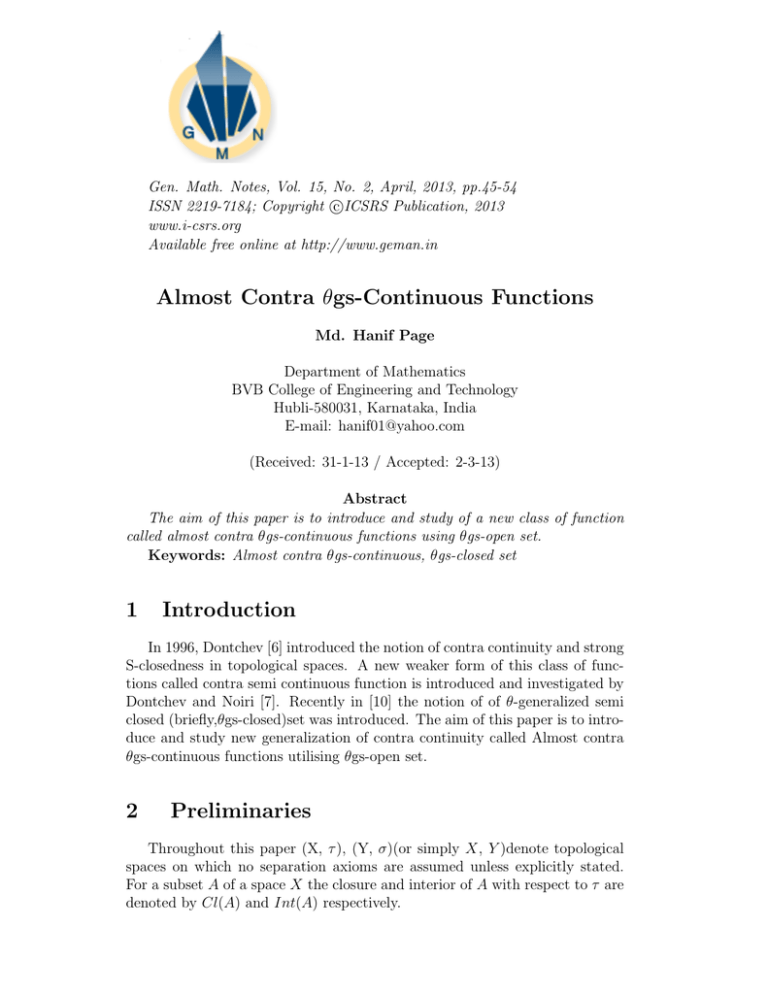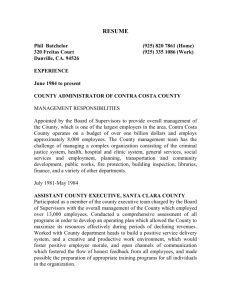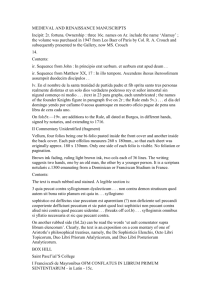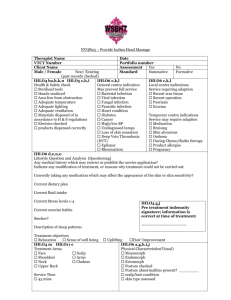Document 10812938
advertisement

Gen. Math. Notes, Vol. 15, No. 2, April, 2013, pp.45-54
c
ISSN 2219-7184; Copyright ICSRS
Publication, 2013
www.i-csrs.org
Available free online at http://www.geman.in
Almost Contra θgs-Continuous Functions
Md. Hanif Page
Department of Mathematics
BVB College of Engineering and Technology
Hubli-580031, Karnataka, India
E-mail: hanif01@yahoo.com
(Received: 31-1-13 / Accepted: 2-3-13)
Abstract
The aim of this paper is to introduce and study of a new class of function
called almost contra θgs-continuous functions using θgs-open set.
Keywords: Almost contra θgs-continuous, θgs-closed set
1
Introduction
In 1996, Dontchev [6] introduced the notion of contra continuity and strong
S-closedness in topological spaces. A new weaker form of this class of functions called contra semi continuous function is introduced and investigated by
Dontchev and Noiri [7]. Recently in [10] the notion of of θ-generalized semi
closed (briefly,θgs-closed)set was introduced. The aim of this paper is to introduce and study new generalization of contra continuity called Almost contra
θgs-continuous functions utilising θgs-open set.
2
Preliminaries
Throughout this paper (X, τ ), (Y, σ)(or simply X, Y )denote topological
spaces on which no separation axioms are assumed unless explicitly stated.
For a subset A of a space X the closure and interior of A with respect to τ are
denoted by Cl(A) and Int(A) respectively.
46
Md. Hanif Page
Definition 2.1 A subset A of a space X is called
(1) a semi-open set [9] if A ⊂ Cl(Int(A)).
(2) a semi-closed set [3] if Int(Cl(Int(A))) ⊂ A.
(3) a regular open [23] if A = Int(Cl(Int(A)))
Definition 2.2 [4] A point x ∈ X is called a semi-θ-cluster point of A if
sCl(U ) ∩ A 6= φ, for each semi-open set U containing x. The set of all semiθ-cluster point of A is called semi-θ-closure of A and is denoted by sClθ (A).
A subset A is called semi-θ-closed set if sClθ (A) = A. The complement of
semi-θ-closed set is semi-θ-open set.
Definition 2.3 [10] A subset A of X is θgeneralized semi-closed(briefly, θgsclosed)set if sClθ (A) ⊂ U whenever A ⊂ U and U is open in X. The complement of θgs-closed set is θgeneralized-semi open (briefly,θgs-open).The family of all θgs-closed sets of X is denoted by θGSC(X,τ ) and θgs-open sets by
θGSO(X,τ ).
Definition 2.4 [16] A topological space X is called Tθgs -space if every θgsclosed set in it is closed set.
Definition 2.5 [13] A topological space X is said to be
(i) θgs-T1 space if for any pair of distinct points x and y, there exist θgs-open
sets G and H such that x ∈ G, y ∈
/ G and x ∈
/ H, y ∈ H.
(ii)θgs-T2 if for each pair of distinct points x and y of X, there exist disjoint
θgs-open sets, one containing x and the other containing y.
Definition 2.6 A function f : X → Y is called:
(i) θ-generalized semi-continuous (briefly,θgs-continuous)[11] if f −1 (F ) is θgsclosed set in X for every closed set F of Y .
(ii) contra θgs-continuous [19] if f −1 (F ) is θgs-closed set in X for every open
set F of Y .
Definition 2.7 [12] A function f : X → Y is said to be θgs-open (resp., θgsclosed) if f (V ) is θgs-open (resp., θgs-closed) in Y for every open set (resp.,
closed) V in X.
Definition 2.8 [23] (i)A topological space X is called Ultra Hausdroff space,
if every pair of distinct points of x and y in X, there exist disjoint clopen sets
U and V in X containing x and y respectively.
(ii)A topological space X is called Ultra normal if each pair of disjoint closed
sets can be separated by disjoint clopen sets.
Definition 2.9 [19] A space X is called locally θgs-indiscrete if every θgsopen set is closed in X.
Almost Contra θgs-Continuous Functions
47
Definition 2.10 [17] A topological space X is said to be θgs-normal if each
pair of disjoint closed sets can be separated by disjoint θgs-open sets.
Definition 2.11 [18] A topological space X is said to be
(i)θgs-connected if X cannot be written as union of two non empty disjoint
θgs-open sets.
(ii) θgs-compact if every θgs-open cover of X has a finite subcover.
Definition 2.12 [14] A function f : X → Y is said to be almost continuous
if f −1 (V ) is open in X for each regular open set V of Y .
Definition 2.13 [8] A topological space X is said to be hyperconnected if
every open set is dense.
Definition 2.14 [2] A function f : X → Y is said to be R-map if f −1 (V ) is
regular open in X for each regular open set V of Y .
Definition 2.15 [15] A function f : X → Y is said to perfectly continuous
if f −1 (V ) is clopen in X for each open set V of Y .
Definition 2.16 [21] A space X is said to be weakly Hausdorff if each element
of X is an intersection of regular closed sets.
Definition 2.17 A space X is said to be
(i) Nearly compact [21] if every regular open cover of X has a finite subcover.
(ii) Nearly countably compact [21] if every countable cover of X by regular
open sets has a finite subcover.
(iii) Nearly Lindelöf [21] if every regular open cover of X has a countable
subcover.
(iv) S-Lindelöf [8] if every cover of X by regular closed sets has a countable
subcover.
(v) Countably S-closed [5] if every countable cover of X by regular closed sets
has a finite subcover.
(vi) S-closed [1] if every regular closed cover of x has a finite subcover.
3
Almost Contra θgs-Continuous Functions
In this section, new type of continuity called an almost contra θgscontinuity, which is weaker than contra θgs-continuity is introduced and studied some of their properties.
Definition 3.1 A function f : X → Y is said to be almost contra θgscontinuous if f −1 (V ) is θgs-closed in X for each regular open set V in Y .
48
Md. Hanif Page
Theorem 3.2 If X is Tθgs -space and f : X → Y is almost contra θgscontinuous, then it is contra almost continuous.
Proof. Let U be a regular open set in Y . Since f is almost contra θgscontinuous f −1 (U ) is θgs-closed set in X and X is Tθgs -space, which implies
f −1 (U ) is closed set in X. Therefore f is contra almost continuous.
Theorem 3.3 If a function f : X → Y is almost contra θgs-continuous and
X is locally θgs-indiscrete space, then f is almost continuous.
Proof. Let U be a regular open set in Y . Since f is almost contra θgscontinuous f −1 (U ) is θgs-closed set in X and X is locally θgs-indiscrete space,
which implies f −1 (U ) is an open set in X. Therefore f is almost continuous.
Theorem 3.4 If f : X → Y is contra θgs-continuous then it is almost contra
θgs-continuous.
Proof. Obvious, because every regular open set is open set.
Remark 3.5 Converse of the above theorem need not be true in general as
seen from the following example.
Example 3.6 Let X = Y ={a, b, c}, τ = {X, φ, {a} , {b} , {a, b}} and σ =
{Y, φ, {a} , {a, b}} {b, c}}be topologies on X and Y respectively. We have
θgs-closed sets in X are {X, φ, {a} , {b} , {c} , {a, c} , {b, c}}. Define a function
f : X → Y by f (a) = a, f (b) = b and f (c) = c. Then f is almost contra
θgs-continuous function but not contra θgs-continuous, because for the open set
{a, b} in Y , f −1 ({a, b}) ={a, b} is not θgs-closed in X.
Theorem 3.7 If f : X → Y is almost contra θgs-continuous and X is Tθgs space then f is contra almost continuous.
Proof. Let U be a regular open set in Y . Since f is almost contra θgscontinuous f −1 (U ) is θgs-closed set in X and X is Tθgs -space, which implies
f −1 (U ) is an closed set in X. Therefore f is contra almost continuous.
Theorem 3.8 For a function f : X → Y the followings are equivalent:
(i) f is almost contra θgs-continuous.
(ii) for every regular closed set F of Y , f −1 (F ) is θgs-open set of X.
Proof. (i) ⇒ (ii) Let F be a regular closed set in Y , then Y − F is a regular
open set in Y . By (i), f −1 (Y − F )=X − f −1 (F ) is θgs-closed set in X. This
implies f −1 (F ) is θgs-open set in X. Therefore, (ii) holds.
(ii) ⇒ (i) Let G be a regular open set of Y . Then Y − G is a regular closed
set in Y . By (ii), f −1 (Y − G) is θ-open set in X. This implies X − f −1 (G) is
θgs-open set in X, which implies f −1 (G) is θgs-closed set in X. Therefore, (i)
holds.
Almost Contra θgs-Continuous Functions
49
Theorem 3.9 For a function f : X → Y the followings are equivalent:
(i) f is almost contra θgs-continuous.
(ii) f −1 (Int(Cl(G))) is θgs-closed set in X for every open subset G of Y .
(iii) f −1 (Cl(Int(F ))) is θgs-open set in X for every closed subset F of Y .
Proof. (i) ⇒ (ii) Let G be an open set in Y . Then Int(Cl(G)) is regular
open set in Y . By (i), f −1 (Int(Cl(G))) ∈ θGSC(X).
(ii) ⇒ (i) Proof is obvious.
(i) ⇒ (iii)Let F be a closed set in Y . Then Cl(Int(G)) is regular closed set
in Y . By (i), f −1 (Cl(Int(G))) ∈ θGSO(X).
(iii) ⇒ (i) Proof is obvious.
Theorem 3.10 If f : X → Y is an almost contra θgs-continuous injection
and Y is weakly Hausdorff, then X is θgs-T1 .
Proof. Suppose Y is weakly Hausdorff. For any distinct points x and y in X,
there exist V and W regular closed sets in Y such that f (x) ∈ V , f (y) ∈
/ V,
−1
f (y) ∈ W and f (x) ∈
/ W . Since f is almost contra θgs-continuous, f (V )
and f −1 (W ) are θgs-open subsets of X such that x ∈ f −1 (V ), y ∈
/ f −1 (V ),
y ∈ f −1 (W ) and x ∈
/ f −1 (W ). This shows that X is θgs-T1 .
Corollary 3.11 If f : X → Y is a contra θgs-continuous injection and Y is
weakly Hausdorff, then X is θgs-T1 .
Theorem 3.12 If f : X → Y is an almost contra θgs-continuous injective
function from space X into a Ultra Hausdroff space Y , then X is θgs-T2 .
Proof. Let x and y be any two distinct points in X. Since f is an injective
f (x) 6= f (y) and Y is Ultra Hausdroff space, there exist disjoint clopen sets U
and V of Y containing f (x) and f (y) respectively. Then x ∈ f −1 (U ) and y ∈
f −1 (V ), where f −1 (U ) and f −1 (V ) are disjoint θgs-open sets in X. Therefore
X is θgs-T2 .
Theorem 3.13 If f : X → Y is an almost contra θgs-continuous closed
injection and Y is ultra normal, then X is θgs-normal.
Proof. Let E and F be disjoint closed subsets of X. Since f is closed and
injective f (E) and f (F ) are disjoint closed sets in Y . Since Y is ultra normal
there exists disjoint clopen sets U and V in Y such that f (E) ⊂ U and
f (F ) ⊂ V . This implies E ⊂ f −1 (U ) and F ⊂ f −1 (V ). Since f is an almost
contra θgs-continuous injection, f −1 (U ) and f −1 (V ) are disjoint θgs-open sets
in X. This shows X is θgs-normal.
Theorem 3.14 If f : X → Y is an almost contra θgs-continuous surjection
and X is θgs-connected space, then Y is connected.
50
Md. Hanif Page
Proof. Let f : X → Y be an almost contra θgs-continuous surjection and X
is θgs-connected space. Suppose Y is a not connected space. Then there exist
disjoint open sets U and V such that Y = U ∪ V . Therefore U and V are
clopen in Y . Since f is almost contra θgs-continuous, f −1 (U ) and f −1 (V ) are
θgs-open sets in X. Moreover f −1 (U ) and f −1 (V ) are non empty disjoint and
X = f −1 (U )∪f −1 (V ). This is contradiction to the fact that X is θgs-connected
space. Therefore, Y is connected.
Theorem 3.15 For two functions f : X → Y and g : Y → Z, let g ◦ f :
X → Z is a composition function.Then, the following properties hold
(i) If f is almost contra θgs-continuous and g is an R-map, then g ◦f is almost
contra θgs-continuous.
(ii) If f is almost contra θgs-continuous and g is perfectly continuous, then
g ◦ f is θgs-continuous and contra θgs-continuous.
(iii) If f is contra θgs-continuous and g is almost continuous, then g ◦ f is
almost contra θgs-continuous.
Proof. (i) Let V be any regular open set in Z. Since g is an R-map, g −1 (V )
is regular open in Y . Since f is an almost contra θgs-continuous f −1 (g −1 (V ))=
(g ◦ f )−1 (V ) is θgs-closed set in X. Therefore, g ◦ f is almost contra θgscontinuous.
(ii) Let V be any open set in Z. Since g is perfectly continuous, g −1 (V ) is clopen
in Y . Since f is an almost contra θgs-continuous f −1 (g −1 (V ))=(g ◦ f )−1 (V )
is θgs-open and θgs-closed set in X. Therefore, g ◦ f is θgs-continuous and
contra θgs-continuous.
(iii) Let V be any regular open set in Z. Since g is almost continuous, g −1 (V )
is open in Y . Since f is contra θgs-continuous f −1 (g −1 (V ))=(g ◦ f )−1 (V ) is
θgs-closed set in X. Therefore, g ◦ f is almost contra θgs-continuous.
Theorem 3.16 Let f : X → Y is a contra θgs-continuous and g : Y → Z
is θgs-continuous. If Y is Tθgs -space, then g ◦ f : X → Z is an almost contra
θgs-continuous.
Proof. Let V be any regular open and hence open set in Z. Since g is θgscontinuous g −1 (V ) is θgs-open in Y and Y is Tθgs -space implies g −1 (V ) open
in Y . Since f is contra θgs-continuous f −1 (g −1 (V ))=(g ◦ f )−1 (V ) is θgs-closed
set in X. Therefore, g ◦ f is an almost contra θgs-continuous.
Definition 3.17 A function f : X → Y is said to be strongly θgs-open (resp.
strongly θgs-closed) if image of every θgs-open (resp. θgs-closed) set of X is
θgs-open (resp. θgs-closed) set in Y .
Theorem 3.18 If f : X → Y is surjective strongly θgs-open (or strongly
θgs-closed) and g : Y → Z is a function such that g ◦ f : X → Z is an almost
contra θgs-continuous, then g is an almost contra θgs-continuous.
Almost Contra θgs-Continuous Functions
51
Proof. Let V be any regular closed (resp. regular open) set in Z. Since g ◦f is
an almost contra θgs-continuous, (g ◦ f )−1 (V )=f −1 (g −1 (V )) is θgs-open (resp.
θgs-closed) in X. Since f is surjective and strongly θgs-open (or strongly θgsclosed), f (f −1 (g −1 (V )))=g −1 (V ) is θgs-open(or θgs-closed). Therefore g is an
almost contra θgs-continuous.
Definition 3.19 A topological space X is said to be θgs-ultra-connected if
every two non empty θgs-closed subsets of X intersect.
Theorem 3.20 If X is θgs-ultra-connected and f : X → Y is an almost
contra θgs-continuous surjection, then Y is hyperconnected.
Proof. Let X be a θgs-ultra-connected and f : X → Y is an almost contra
θgs-continuous surjection. Suppose Y is not hyperconnected. Then there exists
an open set V such that V is not dense in Y . Therefore, there exist nonempty
regular open subsets B1 = Int(Cl(V )) and B2 = Y − Cl(V ) in Y . Since f is
an almost contra θgs-continuous surjection, f −1 (B1 ) and f −1 (B2 ) are disjoint
θgs-closed sets in X. This is contrary to the fact that X is θgs-ultra-connected.
Therefore, Y is hyperconnected.
Definition 3.21 A space X is said to be
(i) Countably θgs-compact if every countable cover of X by θgs-open sets has
a finite subcover.
(ii) θgs-Lindelöf if every θgs-open cover of X has a countable subcover.
(iii) mildly θgs-compact if every θgs-clopen cover of X has a finite subcover.
(iv) mildly countably θgs-compact if every countable cover of X by θgs-clopen
sets has a finite subcover.
(v) mildly θgs-Lindelöf if every θgs-clopen cover of X has a countable subcover.
Theorem 3.22 Let f : X → Y be an almost contra θgs-continuous surjection. Then, the following properties hold.
(i) If X is θgs-compact, then Y is S-closed.
(ii) If X is countably θgs-closed, then Y is is countably S-closed.
(iii) If X is θgs-Lindelöf, then Y is S-Lindelöf.
Proof.(i) Let {Vα : α ∈ I} be any regular closed cover of Y . Since f is almost
contra θgs-continuous, {f −1 (Vα ) : α ∈ I} is θgs-open cover of X. Since X is
θgs-compact, there exists a finite subset I0 of I such that X = ∪ {f −1 (Vα ) : α ∈ I0 }.
Since f is surjective, Y = ∪ {Vα ) : α ∈ I0 } is finite subcover for Y . Therefore,
Y is S-closed.
(ii) Let {Vα : α ∈ I} be any countable regular closed cover of Y . Since f is
almost contra θgs-continuous, {f −1 (Vα ) : α ∈ I} is countable θgs-open cover of
X. Since X is countably θgs-compact, there exists a finite subset I0 of I such
52
Md. Hanif Page
that X = ∪ {f −1 (Vα ) : α ∈ I0 }. Since f is surjective, Y = ∪ {Vα ) : α ∈ I0 } is
finite subcover for Y . Therefore, Y is countably S-closed.
(iii) Let {Vα : α ∈ I} be any regular closed cover of Y . Since f is almost contra θgs-continuous, {f −1 (Vα ) : α ∈ I} is θgs-open cover of X. Since X is θgsLindelöf, there exists a countable subset I0 of I such that X = ∪ {f −1 (Vα ) : α ∈ I0 }.
Since f is surjective, Y = ∪ {Vα ) : α ∈ I0 } is finite subcover for Y . Therefore,Y
is S-Lindelöf.
Definition 3.23 A function f : X → Y is said to be almost θgs-continuous
if f −1 (V ) is θgs-open in X for each regular open set V of Y .
Theorem 3.24 Let f : X → Y be an almost contra θgs-continuous and
almost θgs-continuous surjection. Then, the following properties hold.
(i) If X is mildly θgs-closed, then Y is nearly compact.
(ii) If X is mildly countably θgs-compact, then Y is nearly countabaly compact.
(iii) If X is mildly θgs-Lindelöf, then Y is nearly Lindelöf.
Proof.(i) Let {Vα : α ∈ I} be any regular open cover of Y . Since f is almost contra θgs-continuous and almost θgs surjection, {f −1 (Vα ) : α ∈ I} is
θgs-clopen cover of X. Since X is mildly θgs-compact, there exists a finite
subset I0 of I such that X = ∪ {f −1 (Vα ) : α ∈ I0 }. Since f is surjective,
Y = ∪ {Vα ) : α ∈ I0 }, which is finite subcover for Y . Therefore, Y is nearly
compact.
(ii) Let {Vα : α ∈ I} be any countable regular open cover of Y . Since f is
almost contra θgs-continuous and almost θgs surjection, {f −1 (Vα ) : α ∈ I} is
countable θgs-closed cover of X. Since X is mildly countably θgs-compact,
there exists a finite subset I0 of I such that X = ∪ {f −1 (Vα ) : α ∈ I0 }. Since
f is surjective, Y = ∪ {Vα ) : α ∈ I0 } is finite subcover for Y . Therefore, Y is
nearly countably compact.
(iii) Let {Vα : α ∈ I} be any regular open cover of Y . Since f is almost contra
θgs-continuous and almost θgs surjection,, {f −1 (Vα ) : α ∈ I} is θgs-closed cover
of X. Since X is mildly θgs-Lindelof, there exists a countable subset I0 of I such
that X = ∪ {f −1 (Vα ) : α ∈ I0 }. Since f is surjective, Y = ∪ {Vα ) : α ∈ I0 } is
finite subcover for Y . Therefore, Y is nearly Lindelöf.
References
[1] M.E.A. El-Monsef, S.N. El-Deeb and R.A. Mahmud, β-Open sets and
β-continuous mappings, Bull. Fac. Sci. Assint Univ., 12(1983), 77-90.
[2] D.A. Carnahan, Some properties related to compactness in topological
spaces, PhD Thesis, University of Arkansas, (1973).
Almost Contra θgs-Continuous Functions
53
[3] S.G. Crossley and S.K. Hildebrand, Semi-topological properties, Fund.
Math., 74(1972), 233-254.
[4] G.Di. Maio and T. Noiri, On s-closed spaces, Indian J. Pure and
Appl.Math., 18(1987), 226-233.
[5] K. Dlaska, N. Ergun and M. Ganster, Countably S-closed spaces, Mathematica Slovaca, 44(1994), 337-348.
[6] J. Dontchev, Contra continuous functions and strongly S-closed mappings,
Int. J. Math. Sci., 19(1996), 303-310.
[7] J. Dontchev and T. Noiri, Contra semi continuous functions, Mathematica
Pannonica, 10(2) (1999), 159-168.
[8] E. Ekici, Almost contra precontinuous functions, Bull. Malays Math Sci.
Soc., 27(2004), 53-65.
[9] N. Levine, Semi-open sets and semi-continuity in topological spaces, Mer.
Math. Monthly, 70(1963), 36-41.
[10] G. Navavalgi and M.B. Page, On θgs-neighbourhoods, Indian Journal of
Mathematics and Mathematical Sciences, 4(1) (June-2008), 21-31.
[11] G. Navavalgi and M.B. Page, On θgs-continuity and θgs-irresoluteness,
Internatonal Journal of Mathematics and Computer Sciences and Technology, 1(1) (Jan-June-2008), 95-101.
[12] G. Navavalgi and M.B. Page, On θgs-Open and θgs-closed functions,
Proycecciones Journal of Mathematics, 28(April) (2009), 111-123.
[13] G. Navavalgi and M.B. Page, On some separation axioms via θgs-open
sets, Bulletin of Allahabad Mathematical Society, 25(1) (2010), 13-22.
[14] T. Noiri, On almost continuous functions, Ind. J. of Pure and Appl.
Maths., 20(1989), 571-576.
[15] T. Noiri, On super continuity and some strong forms of continuity, Ind.
J. of Pure and Appl. Maths., 15(1984), 241-250.
[16] M.B. Page, On some more properties of θgs-neighbourhodds, American
Journal of Applied Mathematics and Mathematical Analysis, 2(1) (JanJune-2013), 1-5.
[17] M.B. Page, On θgs-regular and θgs-normal spaces, Interanational Journal
of Adavanced Science and Technology, 5(5) (Nov-2012), 149-155.
54
Md. Hanif Page
[18] M.B. Page, On θgs-compact and θgs-connected spaces, International J.
of Math. Sci. and Engg. Appls. (IJMSEA), 7(II) (March-2013), 241-247.
[19] M.B. Page, On contra θgs-continuous functions, (Communicated).
[20] M.K. Singal, A.R. Singal and A. Mathur, On nearly compact spaces, Bol
Unione Mat Ital, 2(1969), 702-710.
[21] T. Soundararajan, Aweakly Hausdorff spaces and cardinality of topological spaces, General topology and its relations to modern analysis and
algebra, III Proc. Conf. Kanpur 1968, Academia, Prague, 41(1971), 301306.
[22] R. Staum, The algebra of bounded continuous functions into a nonarchimedean field, Pacific J. Math., 50(1974), 169-185.
[23] M. Stone, Applications of the theory of boolean rings to general topology,
Trans. Amer. Math. Soc., 41(1937), 374-481.






